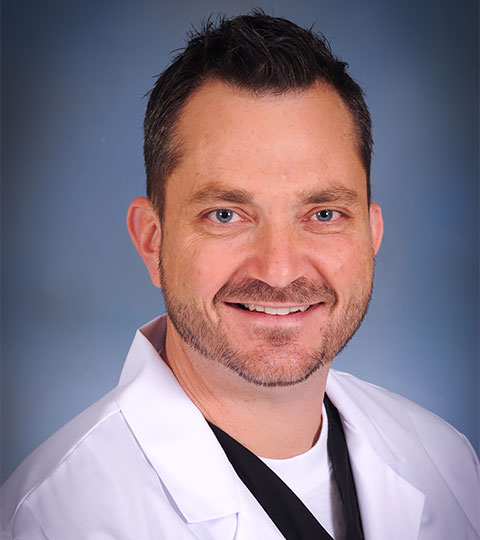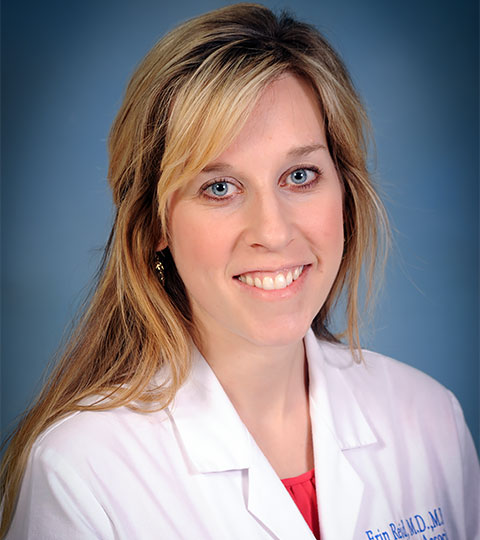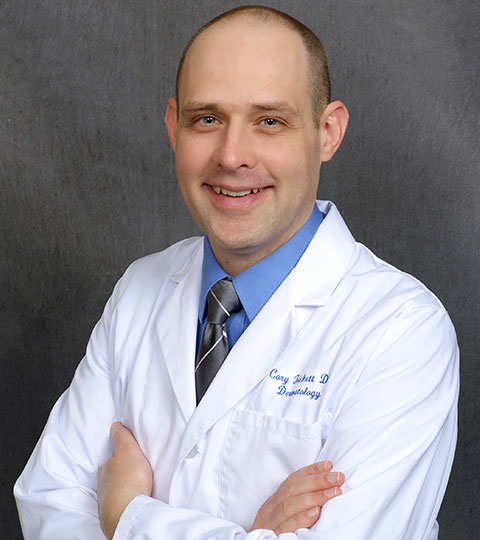 Mohs surgery, also called Mohs micrographic surgery, is a specialized technique for removing skin cancer.
Mohs surgery, also called Mohs micrographic surgery, is a specialized technique for removing skin cancer.
Named for its originator, Dr. Frederic Mohs, Mohs surgery is the treatment of choice for many skin cancers of the head and neck, or those cancers that have recurred after a previous treatment.
Mohs surgery offers the following advantages:
- Highest cure rate – Because all surgical margins are examined microscopically in the office, this procedure has the highest cure rate of all skin cancer treatments.
- Best cosmetic result – Because there is no need to take a margin of healthy skin in Mohs surgery, the size of the wound left after tumor removal is minimized. Keeping the defect small optimizes the surgical repair, and produces a superior cosmetic result.


Chad J. Thomas, MD
- Board Certified Dermatologist
- American College of Mohs Surgery Fellowship Trained
- View curriculum vitae

Erin Reid, MD, MPH
- Board Certified Dermatologist
- American College of Mohs Surgery Fellowship Trained
- View curriculum vitae

Cory Trickett, DO
- Board Certified Dermatologist
- American College of Mohs Surgery Fellowship Trained
- View curriculum vitae
Why You Should Choose a Fellowship-Trained Mohs Surgeon
Mohs College (ACMS) vs Mohs Society (ASMS) – What’s the difference?
Unfortunately, any physician may choose to perform Mohs surgery, even without any specialized training. Many Mohs surgeons advertise they are “certified” or credentialed with governing organizations. Essentially this takes place by two routes: The American College of Mohs Surgery (ACMS) or the American Society of Mohs Surgery (ASMS). Only members of the American COLLEGE of Mohs Surgery have completed a highly competitive 1-2 year fellowship after dermatology residency.
The names are similar but the differences are great.
All three Dermatology Associates’ Mohs surgeons are ACMS Members and are ABD board certified dermatologists.
 You want your skin cancer treatment to be performed with the highest standards of quality and competency. While any board certified dermatologist may perform Mohs surgery, only members of the American College of Mohs Surgery (ACMS) have undergone rigorous fellowship training consisting of over 500 cases of varying complexity and extensive training in skin cancer pathology and facial reconstruction.
You want your skin cancer treatment to be performed with the highest standards of quality and competency. While any board certified dermatologist may perform Mohs surgery, only members of the American College of Mohs Surgery (ACMS) have undergone rigorous fellowship training consisting of over 500 cases of varying complexity and extensive training in skin cancer pathology and facial reconstruction.
Although not always the case with physicians who perform Mohs surgery, all three Mohs surgeons with Dermatology Associates are ACMS Fellowship trained. ACMS is the only organization that requires its members to be accepted and to successfully complete a fellowship that requires at least one full year of training and hands-on experience following completion of a dermatology residency.
About Mohs surgery
Mohs surgery is an outpatient procedure that is performed under local anesthesia; therefore the risks associated with prolonged general anesthesia are avoided. Before the surgery begins, a small needle is used to place the numbing medicine (lidocaine) in the area surrounding the skin cancer. This may cause some discomfort, however, the remainder of the procedure is relatively pain free.
 The surgeon first removes the obvious skin cancer that can be seen with the unaided eye. Next, a very thin saucer-shaped layer of normal appearing skin is removed taking special care to map the tissue so that the surgeon is able to determine the corresponding margins on the patient. The tissue is then processed by the laboratory located in our office – a process that takes about an hour. Because there is a direct transfer of the tissue from the surgeon to the lab, the tissue can be prepared in a special manner that enables the doctor to examine the entire bottom surface and outside edges of the tissue.
The surgeon first removes the obvious skin cancer that can be seen with the unaided eye. Next, a very thin saucer-shaped layer of normal appearing skin is removed taking special care to map the tissue so that the surgeon is able to determine the corresponding margins on the patient. The tissue is then processed by the laboratory located in our office – a process that takes about an hour. Because there is a direct transfer of the tissue from the surgeon to the lab, the tissue can be prepared in a special manner that enables the doctor to examine the entire bottom surface and outside edges of the tissue.
This differs from the frozen sections prepared in a hospital setting which, in fact, represent only a small portion of the true tumor margins. After processing, the surgeon uses a microscope to trace the roots of the skin cancer to see if the entire tumor has been removed. If the margins are clear, and the tumor has been completely removed, then the surgeon will repair the wound that was created by tumor removal. The repair usually involves sutures (stitches).
If the margins are not clear, meaning that some of the tumor was left behind, then the surgeon will go back and remove the edges only in the area where the roots were left behind. This tissue will likewise be processed and examined with a microscope. If tumor removal is complete, then sutures will be used to repair the defect, if not, then another layer of skin will be taken. This process is repeated as many times as necessary until the entire tumor is removed.
Because the number of stages involved with each case is unpredictable, it is impossible to know how long the surgery will take. For this reason, it is important for patients to plan on spending the entire day with us. Bring a good book and whatever else will help keep you comfortable while you are with us.
Learn more about Mohs surgery from:
American College of Mohs Micrographic Surgery
We look forward to making sure your experience with Mohs Micrographic surgery is a positive one and appreciate the opportunity to serve you. Please do not hesitate to call with any questions or concerns.
Questions concerning your upcoming surgery can be addressed by our Mohs Support Specialist:
Johnson City
423-928-8088
Kingsport
423-230-3145
Bristol
423-764-7131 ext. 5094
Resources
